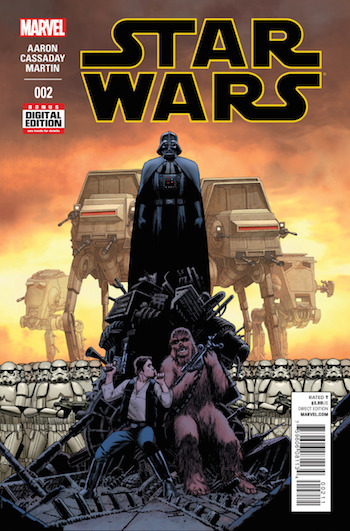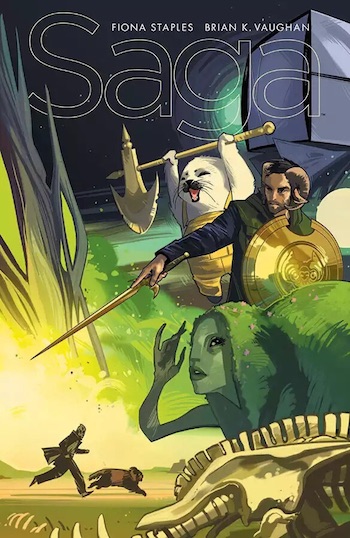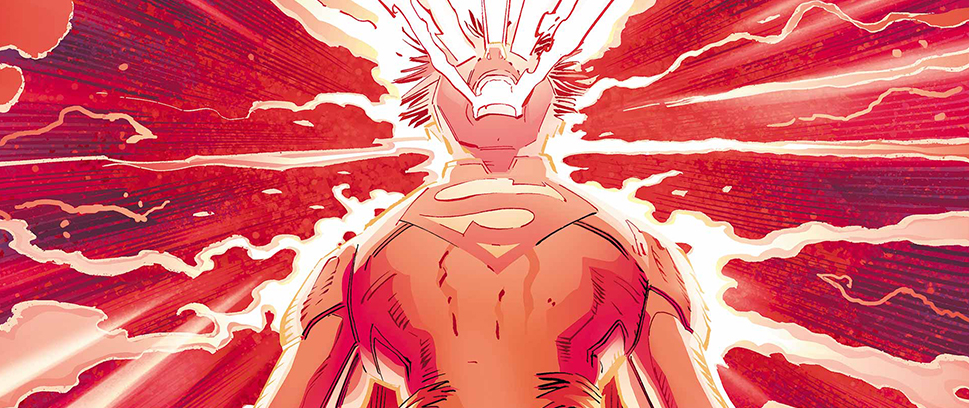
Last Week’s Comics 2/11/15
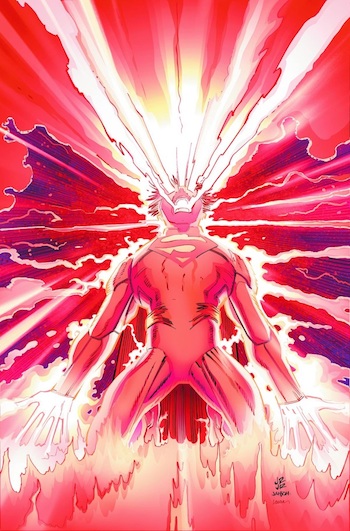 Superman #38
Superman #38
DC – writer: Geoff Johns; art: John Romita Jr.
So Superman’s got a new power, and a new costume. Check. But what about the story? Does the story necessitate such a change in character? Is Johns right to give Big Blue his first new major ability since the 1940s? Unfortunately, It’s hard to see the point in any game changer that comes out of this comic.
First, the Solar Flare. Superman is like a charged battery, and his heat vision, according to Batman, “is actually a precursor to another ability.” Basically, Superman can now unleash all the energy stored in his cells. The good news is that it seems to really incapacitate enemies. The bad news is that it destroys everything in the neighborhood and drains Superman of his powers so he’s human until his body can regenerate that same energy.
I’ll start with my first question – Why? Johns’ whole run has been about the humanity of the character, and he used Ulysses as the foil for that. Ulysses, like Superman, was from a dying world which necessitated a transition to a planet which granted him immense power. But the difference between Superman and Ulysses is Superman’s humanity – the Clark Kent side of the character. Clark tries to get the point across that there is no perfect world and that what makes a world tolerable or livable is hope.
Enter the Solar Flare. Clark is now as human as everyone else on earth because . . .
Well, that’s what I can’t figure out. Because it’s different? It’s new? We haven’t seen it before? Not because the character needed changing, but because it seems Johns felt that he had to pull a Green Lantern on
Superman and try to make major canonical changes to the character in order to make him more interesting. It worked for the Lantern. Expanding Hal’s universe led to some incredible storytelling. But Clark is not the brash and arrogant Hal Jordan. He’s a guy who would take time from fighting a monster to get a kitten out of a tree. This concept is a constant struggle for any writer. How do you make a God relatable?
The comic also doesn’t get the resolution it needs to really explain the impetus for these changes because Johns spends the majority of the issue having the characters fight. We get a Batman cameo and then a hastily put together conclusion that attempts to give some humanity back to Ulysses who, unfortunately, was too good to be true. But at the end of the comic, Ulysses seems like a throwaway villain more than a character with a lasting impact.
Also, Superman isn’t the only person with stellar morals as Jimmy Olson shows what a good guy he is by giving away his billions of inherited dollars. Johns’ explanation for how Olson was able to track down all the
people that needed help is shoddy and laughable and for some reason, Clark decides to tell him, at this moment, that he’s Superman.
Cue new costume and glorious splash page.
Romita’s art is the one saving grace of the comic. While it doesn’t work all the time – his blocky styling and penchant for hatching tends to distort faces in the fight scenes at the beginning – it’s solid when it’s
cleanly inked. The scenes with Superman’s solar flare are pretty impressive and the swath of his destruction is definitely conveyed. Here, the power looks as imposing as it should and I personally think this is what Johns should focus on. The man is a ticking time bomb rather than a champion of the people.
I love Geoff Johns. Honestly, the guy’s one of my favorite comic book writers, but this didn’t work for me at all. Johns is no stranger to awesome Superman stories either. His Action Comics run was superb – “Up,
Up And Away” was an arc that specifically dealt in a powerless Superman still finding a way to be heroic by being a great journalist. The talent and the evidence is present for better but for several reasons, “The Men of Tomorrow” fell flat.
New power, new costume, and major changes don’t equal must read stories.
– Brian Bannen
Marvel – Writer: Jason Aaron, Art: John Cassady
For my whole life I have been aware of Star Wars. One of my earliest memories is playing with my older sisters’ action figures from the original 1970s run in the bedroom of the house my family moved out of 30 years ago. I’ve mentioned before that in my lifetime I’ve probably watched the movies close to 50 times each, if not more.
That said, as with many things in life, it’s best to take breaks. The early ‘90s through the early ‘00s was my last significant obsessive phase with the franchise. I feel like the prequels broke many of the original trilogy fans. I was off Star Wars for almost a decade, until the last few years. Between my nephews becoming aware and obsessed with it, the new movie, the excellent Star Wars Minute podcast, and comic series like these and the various Dark Horse series I am now on board again. Jason Aaron and John Cassady bring the fun, albeit the occasionally dark kind, in Star Wars #2.
I’ll admit to being skeptical about Marvel regaining the comic book publishing rights to all things Star Wars. The original Marvel series is nostalgic fun that is still choppy at best, and the usually great Star Wars output by Dark Horse for the last twenty years has eclipsed that run. Weirdly this new Marvel series is following the same basic premise of the original run, but with the advantage of hindsight and history on its side this time. While in the original series the universe was still being built, this one has almost 40 years of backstory to fall back on.
Star Wars #2 throws us in with our favorite group of Rebels being in a pickle, as their attempt to sabotage the biggest Imperial weapons facility went completely wrong. Not only are they trying to get a group of prisoners offworld but Han and Leia must save Luke from getting his ass handed to him by the recently arrived Darth Vader. Not only that but C-3PO is doing a terrible job of preventing the Millennium Falcon from being taken apart for scrap by the squid-faced planetary natives.
In this issue Luke and Vader square off, which is a little odd and initially rubbed me the wrong way, but Aaron plants the seeds to let us know that this all makes sense in the context of this period of time between episodes IV and V. Since this series has been declared to be official canon by the all-powerful corporate owners Disney hopefully things don’t get too confusing like the prequels. After Revenge of the Sith I’ve ignored those and never looked back.
Vader’s attitude and mission statement has always seemed somewhat different between the episodes IV and V, and a lot of that can be attributed to the fact that he doesn’t become of aware of his past and who he was until some point between those movies. In this issue it is when Vader takes Luke’s lightsaber, the really familiar blue one, and has a serious rush of memories that we can see the switch going off in Vader’s head. From here on I won’t be surprised if Vader starts laying down the plans that ultimately leads to his scheme to try to capture Luke in Empire.
One thing that this issue has in spades is dark humor. Jason Aaron has never been afraid to kill characters off, sometimes for a laugh. While this can be a dicey prospect usually there is something kind of insane and ridiculous about Vader ripping through prisoners and the occasional Stormtrooper with his dual lightsaber attack, as he’s basically overloaded and in complete beserker mode. Also Han and Leia having difficulties with their recently acquired AT-AT, which leads to Leia chastising Han by saying “You nearly stepped on a Twi’lek!”
John Cassady’s art is great as usual. His renditions of landscape and machines and vehicles are wonderful, and he’s able to cram a lot of detail into every panel. The randomness of the alien races among the prisoners that he draws reminds me of when I used to play with the toys and have Hammerhead and 4-LOM go along with the good guys for a mission. For the most part his facial referencing is good, although there are weird angles where Luke doesn’t look so much like Mark Hamill and more like a cartoon, and also sometimes the same for Han not looking like Harrison Ford. This is a minor quibble though, and always a problem with art that uses actors and actresses as reference anyway.
My only other complaint is a general Star Wars complaint that’s unavoidable, and that’s the repetitious nature of tropes in all of the Star Wars lore. C-3PO being taken apart, R2 fixing the tech issues just in the nick of time, the rehashing of lines to an almost awkward degree, and the singular nature of a lot of the alien species and planets in the universe. I’ve always just accepted these as Star Wars tropes that give the series its identity though, and can excuse it for an overall fun and exciting story featuring characters I love.
Speaking of characters I love, where was Chewie in this issue? Ok, that was one more complaint.
So far, so good. I’m hoping this tone will continue for a while in this book, as there are a surprising amount of places to take this story even within the established continuity. It’s nice to be back in the Star Wars universe again, and to be having fun with characters that I’ve known all my life.
Image – Writer: Brian K. Vaughn, Art: Fiona Staples
After a little bit of a break Brian K. Vaughn and Fiona Staples return in a mighty way with Saga #25. Before checking in with our characters they present a flashback to the history of the war at the center of the story via a series of images that evoke World War II newsreels. Initially presented with the patriotism and gusto you’d expect from such propaganda it also eerily reflects United States military history, as the mandatory draft on the planet of winged inhabitants known as Landfall gives way to a volunteer-only military force. This leads to dangerous detachment as the military volunteers are mostly the poor and disenfranchised youth with no other options. Meanwhile the wealthy and better off essentially ignore the war their planet is waging that is destroying so many lives. Because this war is with the magic-wielding inhabitants of Landfall’s only moon The Wreath it becomes necessary to outsource it away from their homeworlds, so as not to destroy themselves.
A poignant shot of innumerable gravestones, looking similar to those at Arlington Cemetery, brings us to where the story is at now. What’s amazing about this is Vaughn’s investment in his characters and the fact that he held out for 25 issues before laying out the history of this war. Most space opera tries to get the history out of the way immediately with some sort of exposition dump, but Vaughn has enough faith in the story at the heart of all this horrible and pointless conflict that he only now clues us in to the reason why Alana and Marko meet.
This is also why the narrator Hazel is born, a character who, at this point in the flashback, is old enough to string random babbling sentences together but still not at the speaking level reflected in her narrative. Her conversation with the TV-headed psychopath Dengo is a wonderful detail by Vaughn, and relatable to any parent or person with younger relatives. I’ve heaped so much praise on Vaughn’s writing at this point I really can only add little ancillary compliments to the mountainous pile.
Fiona Staples does wonderful work as always, and to start the gatefold cover for this issue is wonderful. As I said above the attention to detail in the newsreel-style footage is fantastic. Just the way the shots are laid out and framed tell the story on their own, especially with the shot of the cemetery. Take away the words and many could figure out what the history of the war is just based on the images, and how it affects the unfortunate souls that are dragged into it, and how ultimately it affects us all.
Speaking of unfortunate souls things are not looking good for Alana, her mother, and the other prisoners of Dengo. When Hazel says in narration that she doesn’t see her father again for two years it really hurts, because as Marko and Prince Robot IV are bickering their way and trying to find their kidnapped children we realize that they may not make it in time to save everyone. Especially with the reveal in the last panel of a dangerous-looking group of aliens who are part of Dengo’s revolution.
What’s brilliant about this series is how contained it’s been until now. With the big picture reveal does that mean we may see more of what’s going on in this universe? Also what role do The Brand, Gwendolyn, Sophie and possibly The Will play in all this? What’s amazing about Saga is that these characters may be the saviors, they may die in their quest to cure The Will, or they may end up continuing onto another unrelated (?) quest. Much like war and life, a lot of times it’s a chaotic mess that often doesn’t make sense until someone is telling the story years later.
The parallel to World War II and other recent wars at the beginning really reminds the reader that, while the stuff we’re seeing is weird, it’s really just another variation on our story as well as theirs, at least in the big picture. When you zoom in there’s millions of unique stories to be told. Hopefully Vaughn and Staples have at least a million left to tell.
– Michael Edwards
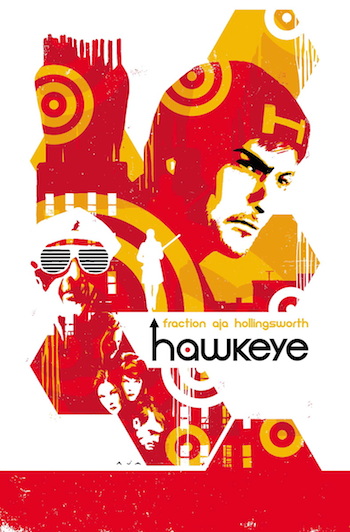 Hawkeye # 21
Hawkeye # 21
Marvel – Writer: Matt Fraction; Art: David Aha, Raul Allen and Matt Hollingsworth.
Hawkguy is back (and it’s almost over)!
A few nights ago, Unwinnable attorney (and film buff of the highest order) Ed Coleman and I were talking about Howard Hawk’s western siege epic, Rio Bravo and Hawks’ (along with screenwriter Leigh Brackett and star John Wayne) penchant to remake that movie not once, but twice in the forms of El Dorado and Rio Lobo. Rio Bravo is the story of a lawman and a ragtag group of allies holding their own against some bad guys laying siege on the local jail. Aside from Hawks’ two remakes, one can see the film’s cinematic DNA in films like Assault on Precinct 13, Die Hard and even Joss Whedon’s Avengers movie. Rio Bravo is such influential film that the United States Library of Congress selected it for preservation in the National Film Registry last year.
Hawkeye # 21, as its title suggests, pays homage to Hawks’ classic. It’s the penultimate chapter of Fraction, Aja and company’s run. Clint Barton’s main foils of the series have been the Tracksuit Draculas. They’re a bunch of vaguely Eastern European gangsters who want to take Clint Barton’s building in the Bedford Stuyvesant section of Brooklyn.
Over the course of the series, Clint alienated a lot of his friends, including his superhero girlfriend Spider-Woman, protégé Kate Bishop and the ever loyal Pizza Dog. He may not legally own the building he’s been living in and protecting. Kazi the Clown murdered Clint’s buddy, Gil, while he was grilling hot dogs. And for an encore? Kazi put Clint’s brother in a wheelchair and deafened Clint.
“How much worse can it get?”
You had to ask, Clint. you had to ask…
Fraction, Aja, Raul Allen and company tell a grueling tale in this, the penultimate chapter of Hawkeye. The book makers and their collaborators spent a lot of this series introducing readers to Clint’s neighbors and they stand together against the Tracksuit Draculas in the Battle of Bed-Stuy. It’s an exciting to see Clint and his neighbors tricking and fighting the thugs but the tale takes a gut-wrenching turn.
When Hawkeye and Barney face off against Kazi and the head Bro, Aja, Allen and colorist Matt Hollingsworth deliver. Hollingsworth changes the color pallet as Aja and Allen place empty, black panels alternating with Clint getting beaten and then dragged around. It’s a terrifying sequence that left me with both dread and anticipation.
Matt Fraction, David Aja, Matt Hollingsworth, Chris Eliopoulos, Annie Wu, Francesco Francavilla, Javier Pulido, Steve Lieber, Sana Amanat and Steve Wacker brought us a comic worthy of Walt Simonson’s Thor, Chris Claremont and John Byrne’s Uncanny X-Men and Frank Miller’s Daredevil. I’m going to miss this book when it’s gone and I am going to read it quite a few times over the next few years. But first, I am going to read Hawkeye # 21 again and wait with baited breath for # 22.
– Ian Gonzales
